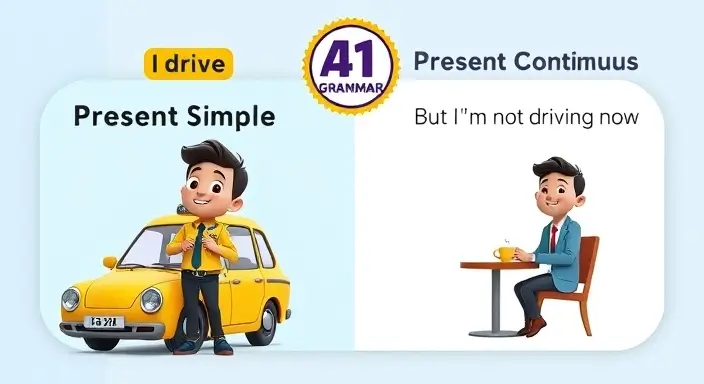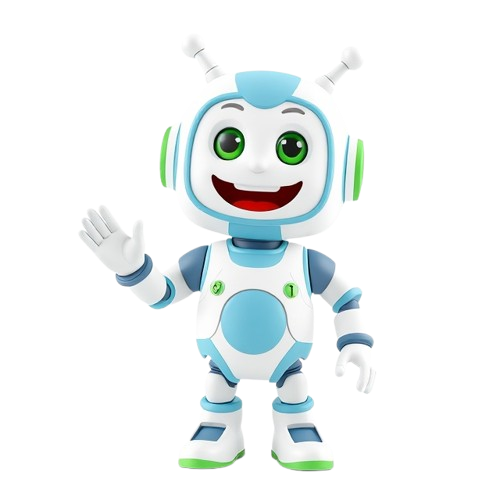Present simple or present continuous?
- Home ›
- Grammar ›
- A1 Elementary ›
- Present simple or present...




Choose the correct present simple or present continuous form to complete the dialogues below.
Complete the following sentences choosing the correct present simple or present continuous forms.
Complete the following postcard with the verbs in brackets in present simple or present continuous.

- 21 November, 2024
- 423
- Grammar
- A1 Elementary
Present simple or present continuous?
Understanding the difference between the present simple and the present continuous tenses is essential for talking about habits, routines, actions happening now, or temporary situations. Let’s dive into each case to ensure you can use these tenses correctly in your daily conversations.
When Do We Use the Present Simple?
The present simple tense is used for actions that are repeated regularly, permanent situations, or general truths.
1. Habits or Routines
We use the present simple to describe actions that happen repeatedly, often following a specific pattern or schedule.
- I brush my teeth every morning.
- He goes to school on weekdays.
- We play football on Saturdays.
2. Permanent Situations
This tense is also used for situations that are always true or rarely change.
- She lives in New York.
- Water boils at 100 degrees Celsius.
- My brother has two children.
3. Facts or General Truths
The present simple is perfect for stating universal facts or unchanging truths.
- The Earth revolves around the Sun.
- Cats like to sleep during the day.
4. Expressions of Frequency
Words like "always," "never," "sometimes," and "often" are commonly used with the present simple to describe how often something happens.
- He always drinks coffee in the morning.
- They never miss a class.
When Do We Use the Present Continuous?
The present continuous tense focuses on actions happening now or around this moment. It is also used for temporary situations.
1. Actions Happening Right Now
When something is happening at the exact moment of speaking, we use the present continuous.
- I’m reading a book right now.
- She’s talking to her friend.
- They’re watching TV.
2. Temporary Situations
If an action or state is not permanent and is only happening for a short time, the present continuous is appropriate.
- He’s working in London this month.
- We’re staying at a hotel for the weekend.
3. Trends or Changes
The present continuous can describe trends or ongoing changes in the world.
- People are using electric cars more these days.
- The climate is getting warmer.
4. Future Plans (with Time Expressions)
The present continuous can also express fixed plans or arrangements for the near future.
- We’re meeting our friends tomorrow.
- She’s flying to Paris next week.
How to Decide: Present Simple or Present Continuous?
Sometimes, it’s tricky to decide which tense to use. The table below summarizes their differences:
| Situation | Present Simple | Present Continuous |
|---|---|---|
| Regular or habitual actions | I drink coffee every morning. | ✘ |
| Actions happening now | ✘ | I’m drinking coffee right now. |
| Permanent situations | He works as a doctor. | ✘ |
| Temporary actions | ✘ | He’s working as a waiter for now. |
| Scheduled events (future meaning) | The train leaves at 8 PM. | We’re leaving at 8 PM tomorrow. |
Common Mistakes
-
Using the present continuous with stative verbs: Some verbs, like "know," "like," or "need," describe states, not actions, and are not used in the continuous form.
- Correct: I like chocolate.
- Incorrect: I’m liking chocolate.
-
Confusion between now and regular actions: Don’t use the present simple for things happening at this moment.
- Correct: She’s playing the piano.
- Incorrect: She plays the piano (if describing a current action).
Practice Makes Perfect
Let’s see how well you’ve understood. Choose the correct form for each sentence:
- (A) I always drink tea in the morning. (B) I’m always drinking tea in the morning. (Correct Answer: A – habitual action)
- (A) She studies English now. (B) She’s studying English now. (Correct Answer: B – action happening now)
Final Tip
Remember:
- Use present simple for routines, facts, and permanent situations.
- Use present continuous for actions happening now, temporary situations, or future plans.
Unfortunately, we currently do not have teaching materials available on this topic. We are working with all our efforts to prepare it. You can subscribe to Verbooze to be notified once the teaching materials are ready.




English Learning Made Easy & Accessible for Everyone
Boost your English skills with interactive lessons, grammar explanations, reading and listening exercises, and real-time feedback. Join our growing community and start improving today — all completely free!

